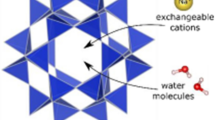Abstract
Crystalline silicotitanate ion exchanger (58.5 mmol Ti, and 620 mmol Na) with 6 mmol of SiO2 after 10 days of hydrothermal synthesis was optimized for selective removal of 90Sr. Studies on X-ray diffraction, scanning electron microscope and energy dispersive spectroscopy revealed that the silicotitanate is highly crystalline with bright cubic and rod like morphology with varying amounts of Ti, Si, Na, and O. The decontamination factor and distribution coefficient values for uptake of 137Cs and 90Sr from actual radioactive waste solutions by the ion exchanger after 24 h of equilibration was found to be 40 and 176 and 4025 ml g−1 and 7525 ml g−1, respectively. The exchange capacity for 90Sr and 137Cs was estimated to be 14.6 and 4.4 meq g−1, respectively.







Similar content being viewed by others
References
Yu B, Chen J, Song C (2002) Crystalline silicotitanate: a new type of ion exchanger for Cs removal from liquid waste. J Mater Sci Technol 18(3):206–210
Risto Koivula report series in radiochemistry 23 (2004) Inorganic ion exchangers for decontamination of radioactive wastes generated by the nuclear power plants
Miller JE, Brown NE (1997) Development and properties of crystalline silicotitanate (CST) ion exchangers for radioactive wastes applications. SAND97-0771
Moller T, Clearfield A, Harjula R (2002) Preparation of hydrous mixed metal oxides of Sb, Nb, Si, Ti and W with a pyrochlore structure and exchange of radioactive cesium and strontium ions into the materials. Microporous Mesoporous Mater 54:187–199
Rathore NS, Anil Kumar P, Venugopalan AK (2004) Removal of actinides and fission products activity from intermediate alkaline wastes using inorganic exchangers. J Radioanal Nucl Chem 262(3):543–549
Mishra SP, Tiwari D, Prasad SK, Dubey RS, Mishra A (2006) Inorganic ion exchangers in radioactive waste management part XVI: uptake of some metal phosphates (stannic and zirconium for 134Cs. J Radioanal Nucl Chem 268(2):191–199
Venkatesan KA, Sukumaran V, Antony MP, Srinivasan TG (2009) Studies on feasibility of using crystalline silicotitanates for the separation of cesium-137 from fast reactor high-level liquid waste. J Radioanal Nucl Chem 280(1):129–136
Nyman M, Gu BX, Wang LM, Ewing RC, Nenoff TM (2000) Synthesis and characterisation of new microporous cesium silicotitanate (SNL-B) molecular sieve. Microporous Mesoporous Mater 40:115–125
Luca V, Hanna JV, Smith ME, James M, Mitchell DRG, Bartlett JR (2002) Nb-substitiution and Cs+ ion-exchange in the titanosilicate sitinakite. Microporous Mesoporous Mater 55:1–13
Andrews MK, Fellinger TL, Ferrara DM, Harbour JR, Herman DT (1997) Vitrification of cesium loaded crystalline silicotitanate (CST) in the shielded cells melter. WSRC-TR-9700314
Moller T (2002) Selective crystalline inorganic materials as ion exchangers in treatment of nuclear waste solutions. Academic Dissertation, Helsinki
Anthony RG, Dosch RG, Philip CV (2002) Method of using novel silicotitanates. US Patent No. 6,479,427
Tripathi A, Medvedev DG, Nyman M, Clearfield A (2003) Selectivity for Cs and Sr in Nb-substituted titanosilicate with sitinakite topology. J Solid State Chem 175:72–83
Oji LN, Martin KB, Hobbs DT (2009) Development of prototype titanate ion-exchange loaded membranes for Sr, Cs and actinide decontamination from aqueous media. J Radioanal Nucl Chem 279(3):847–854
Cherry BR, Nyman M, Alam TM (2004) Investigation of cation environment and framework changes in silicotitanate exchange materials using solid-state 23Na, 29Si, and 133Cs MAS NMR. J Solid State Chem 177:2079–2093
Ali IM, Zakaria ES, Aly HF (2010) Highly effective removal of 22Na, 134Cs and 60Co from aqueous solutions by titanosilicate: a radiotracer study. J Radioanal Nucl Chem 285(3):483–489
Brown GN, Carson RJ, Deschane JR, Elovisch RJ (1997) Performance evaluation of 24 ion exchange materials for removing cesium and strontium from actual and simulated N-reactor storage basin water. PNNL-11711 UC-2030
James EM, Norman EB (1997) Development and properties of CST ion exchanger for radioactive waste applications. SANDIA 97-0771.UC-7221, UC-510
Yates SF, Sylvester P (2001) Sodium nonatitanate: a highly selective inorganic ion exchanger for strontium. Sep Sci Technol 36(5):867–883
Lehto J, Clearfield A (1987) The ion exchange of strontium on sodium titanate Na4Ti9O20·XH2O. J Radioanal Nucl Chem 118(1):1–13
Acknowledgements
The authors acknowledge Shri P. T. Hariharan, CWMF for surface area analysis and Shri T. S. S. Raghavan, CWMF for technical assistance.
Author information
Authors and Affiliations
Corresponding author
Rights and permissions
About this article
Cite this article
Chitra, S., Shanmugamani, A.G., Sudha, R. et al. Selective removal of cesium and strontium by crystalline silicotitanates. J Radioanal Nucl Chem 312, 507–515 (2017). https://doi.org/10.1007/s10967-017-5249-3
Received:
Published:
Issue Date:
DOI: https://doi.org/10.1007/s10967-017-5249-3



